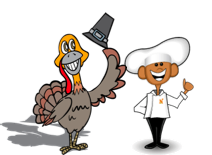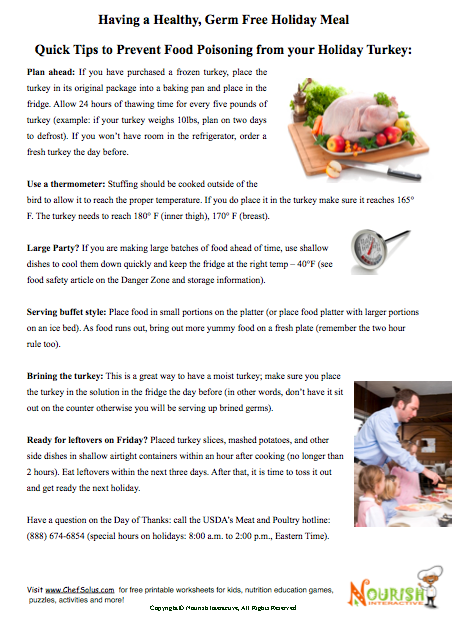 Thanksgiving is tomorrow, and it's time to talk turkey....'turkey food safety' that is! In this post you'll find cooking time and food safety facts for cooking your holiday turkey safely. We also have information on safely storing leftovers.
Thanksgiving is tomorrow, and it's time to talk turkey....'turkey food safety' that is! In this post you'll find cooking time and food safety facts for cooking your holiday turkey safely. We also have information on safely storing leftovers.
Turkey is a very good source of protein, selenium, niacin, vitamin B6 and the amino acid tryptophan. It’s a good source of zinc and vitamin B12. The skinless white meat is an excellent high-protein, low-fat food.
For those who prefer a vegetarian Thanksgiving, our recent post about alternative recipes is very popular this year. We have a roundup of 30 creative new Thanksgiving recipes - seasonal vegetables appetizers, soups, main dishes, desserts and some special recipes from Meatless Monday.
For those cooking turkey- here's some Turkey safety tips, printable food safety facts for adults and a children's version for kitchen food safety too!
Cooking time and temperature for your Thanksgiving Turkey
 Time to cook turkey. There are many ways to cook a turkey, roasting, deep frying, barbecuing and more! The most important thing to do no matter how you are cooking your turkey is to measure the internal temperature of the turkey with a meat thermometer to make sure it is fully cooked. A stuffed turkey will take more time.
Time to cook turkey. There are many ways to cook a turkey, roasting, deep frying, barbecuing and more! The most important thing to do no matter how you are cooking your turkey is to measure the internal temperature of the turkey with a meat thermometer to make sure it is fully cooked. A stuffed turkey will take more time.
How to add stuffing to the turkey: Stuffing should be prepared and stuffed into the turkey immediately before it’s placed in the oven. Mix the wet and dry ingredients for the stuffing separately and combine just before using. Stuff the turkey loosely, about 3/4 cup stuffing per pound of turkey.
Bake any extra stuffing in a greased casserole dish. Cooked inside or outside the bird, all stuffing and dressing recipes must be cooked to a minimum temperature of 165 °F.
Where to put the temperature? ! Insert a meat thermometer into the thickest part of the thigh, not touching bone. Cook to a minimum internal temperature of 165 °F- Check the internal temperature in the innermost part of the thigh and wing and the thickest part of the breast. Turkeys can be cooked to a higher temperature but not to exceed 170 °F in the breast and 180 °F in the thigh. (If the turkey is done and the stuffing is not yet 165 °F, remove the stuffing from the turkey and place it in a greased casserole dish to continue cooking to temperature.)
Thermal/Conventional Oven Open Pan Method Timetable for Roasting a Turkey at 325 °F.
| Unstuffed Turkey | |
| 8 to 12 pounds 12 to 14 pounds 14 to 18 pounds 18 to 20 pounds 20 to 24 pounds | 2-3/4 to 3 hours 3 to 3-3/4 hours 3-3/4 to 4-1/4 hours 4-1/4 to 4-1/2 hours 4-1/2 to 5 hours |
| Stuffed Turkey | |
| 8 to 12 pounds 12 to 14 pounds 14 to 18 pounds 18 to 20 pounds 20 to 24 pounds | 3 to 3-1/2 hours 3-1/2 to 4 hours 4 to 4-1/4 hours 4-1/4 to 4-3/4 hours 4-3/4 to 5-1/4 hours |
Convection Oven Open Pan Method Roasting Guidelines for a Fresh/Thawed Turkey at 300 °F.
| Unstuffed Turkey | |
| 14 to 18 pounds 18 to 22 pounds | 2-1/2 to 3-1/4 hours 3-1/4 to 3-1/2 hours |
| Stuffed Turkey | |
| 14 to 18 pounds 18 to 22 pounds | 3 to 3-1/4 hours 3-1/4 to 3-3/4 hours |
Source: www.holidayfoodsafety.org
Healthy Printables from our Website Nourish Interactive:
Kids in the Kitchen Food Safety Checklist 2 Page PDF (Spanish Version)
Printable Cooking Turkey Food Safety Guide (Spanish PDF)
Click to View and Print Thanksgiving Activity Pages for Kids! (Spanish) Print nutrition themed Thanksgiving coloring pages, guest seat cards, I'm thankful for page, word searches, puzzles and more!
You may also be interested in:
Fun active Thanksgiving games to get the family moving!

0 Comments